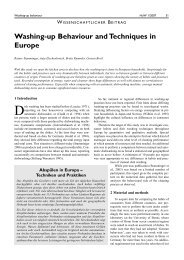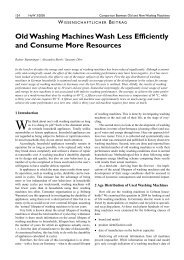Development of a novel mechatronic system for mechanical weed ...
Development of a novel mechatronic system for mechanical weed ...
Development of a novel mechatronic system for mechanical weed ...
Create successful ePaper yourself
Turn your PDF publications into a flip-book with our unique Google optimized e-Paper software.
5.1.2 Results <strong>of</strong> the accuracy test<br />
Results and discussion<br />
The accuracy tests conducted on the row with 5 mm wood sticks proved the<br />
Nyquist–Shannon sampling theorem (Jerri 1977) that the sampling distance<br />
during the detection needs to be at least two times lower than the size <strong>of</strong> the<br />
objects. A number <strong>of</strong> numeric calculations and I/O operations with a sampling<br />
distance lower than 5 mm can overrun the allowed time limits predicted <strong>for</strong> VI<br />
execution and cause delays in execution <strong>of</strong> the main hoeing algorithm in real-<br />
time. Because <strong>of</strong> that, the size <strong>of</strong> the object which can be detected with the<br />
developed <strong>system</strong> is limited to 10 mm.<br />
The accuracy tests conducted on the row with 10 mm wood sticks showed that<br />
both <strong>of</strong> the sensors can be used <strong>for</strong> fairly accurate detection <strong>of</strong> the object. All<br />
the wood sticks in the experimental row were detected with the RGB sensor as<br />
objects sized between 5 mm and 20 mm when sampling distance was 5 mm<br />
and as objects sized between 2 mm and 20 mm when sampling distance was 2<br />
mm. The dispersions <strong>of</strong> the detected objects size generated by RGB and laser<br />
sensor <strong>for</strong> experiments with 2 mm and 5 mm sampling distance are presented<br />
in Figure 5.4.<br />
Obviously, the size <strong>of</strong> the objects detected with RGB sensor frequently exceeds<br />
the size <strong>of</strong> the measured objects. As an argument why such an error appears is<br />
the shape and size <strong>of</strong> the fibre optic sensor’s light emitter. The spot diameter <strong>of</strong><br />
the light emitter is around 5 mm and the sensor can detect the object when<br />
approximately one half <strong>of</strong> the emitted light returns to the receiver. It can happen<br />
two times, first when the sensor approaches the object from the front side and<br />
second time when the sensor leaves the object on the back side. According to<br />
this explanation the number <strong>of</strong> impulses which corresponds to one object can<br />
be higher up to 2 impulses per object <strong>for</strong> sampling distance 5 mm and up to 5<br />
impulses per object <strong>for</strong> sampling distance 2 mm, depending on the RGB<br />
sensors position when the sampling executes.<br />
As mentioned be<strong>for</strong>e, with a sampling distance 2 mm an overrun <strong>of</strong> the allowed<br />
time limits predicted <strong>for</strong> VI execution can appear and that is the reason why<br />
some <strong>of</strong> the wood sticks were detected as 2 mm, 4 mm and 6 mm sized<br />
63





